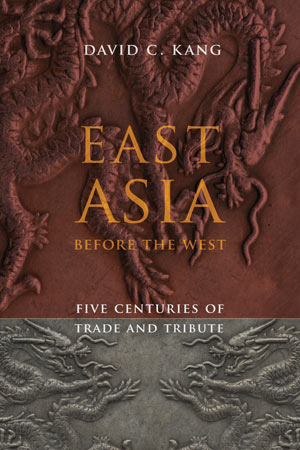
My book set out to answer one general and seemingly simple question: How did international relations function in East Asia from the fourteenth century to the nineteenth, before the arrival of the Western imperial powers?
I make one overarching argument: that East Asian international relations exhibited two historical patterns, both of which were different from the European experience with the “balance of power.” The four main states of historical East Asia (Korea, Vietnam, Japan, and China) had generally stable and clear borders with each other and very little war. At the same time, the four states had endemic conflict with the various “nomadic” tribes and groups which existed along a vast frontier zone.
In explaining this pattern, I argue that a set of international rules and institutions—known as the tribute system—governed the relations of the East Asian states during this time period.
Emphasizing formal hierarchy and yet allowing considerable informal autonomy, Korea, Vietnam, Japan, and China had considerable peace and stability in their relations with each other. By contrast, the European “balance of power” system emphasized formal equality of nation-states, but entailed endemic conflict among states.
Yet not all polities in East Asia played by the tribute system rules. The most fighting and problems occurred between these historical East Asian states and the nomads on their northern and western frontiers.
The system comprised more than just war and diplomacy. Historical East Asia was also an economic international system, with extensive trade relations and cultural exchange among all the units in the region.
China, the hegemon, was more than just a political power. From Siam to Java, to Vietnam, Taiwan, and even Japan, all the states traded with each other and particularly with China.
It is common to use analogies from nineteenth century Europe—such as the rise of Bismarckian Germany—to explain East Asian relations in the twenty-first century. I hope this book contributes to viewing East Asia actually as a region of its own—with different states and distinct patterns, and not simply as a reflection of the Western experience.
Today there is intense interest in whether these states can craft a stable relationship, especially with China’s emergence as an economic powerhouse. Given that they have centuries of history together, it is logical to ask how their relations worked in the past and whether this tells us anything about the present.
“Emphasizing formal hierarchy and yet allowing considerable informal autonomy, Korea, Vietnam, Japan, and China had considerable peace and stability in their relations with each other. By contrast, the European “balance of power” system emphasized formal equality of nation-states, but entailed endemic conflict among states.”
In 1592, the Japanese general Toyotomi Hideyoshi invaded Korea with over 160,000 troops on approximately 700 ships. Intending to conquer China after first subduing Korea, he eventually mobilized half a million troops.
In the “Imjin War,” as it was called in Korea, over 60,000 Korean soldiers, eventually supported by over 100,000 Ming Chinese forces, defended the Korean peninsula. After six years of war, the Japanese retreated. Hideyoshi died, having failed spectacularly in his quest to conquer China and Korea.
The Imjin War easily dwarfed its European contemporaries, involving men and material five to ten times the scale of the Spanish Armada of 1588, often described as the greatest military force ever assembled in Renaissance Europe. That in itself should be sufficient cause for us to explore the causes and consequences of the Imjin War.
Yet even more important for the study of international relations, Hideyoshi’s invasion of Korea marked the only military conflict between Japan, Korea, and China for over six centuries. For three hundred years before the Imjin War, and then for another three hundred years after it, three of the major powers in East Asia coexisted peacefully—despite having the military and technological capability to wage war on a massive scale.
China was clearly the hegemon—a dominant military, cultural, and economic power in the system. But China’s goals did not include expansion against its established neighboring states with which it had stable borders. These smaller Sinicized states emulated Chinese practices and to varying degrees accepted Chinese centrality in the region.
However, my central claim of East Asian stability does not imply that violence was rare in East Asia.
There was plenty of violence. But it tended to occur between China and the semi-nomadic peoples on its northern and western frontiers—not between China and the other Sinicized states. This violence occurred in the form of border skirmishes, piracy, and the slow expansion and frontier. These helped consolidate states such as China at the expense of non-state units.
The peoples in these non-state units differed vastly in worldviews and political structures from the Chinese state encroaching on them—and they resisted Confucian cultural ideas. The frontier was only turned into a border when China expanded westward, and other states such as Russia began to expand eastward, which left the nomads with nowhere to move.
I became interested in this era because many of us who study the international relations of East Asia focus almost exclusively on the 20th century.
Furthermore, specialists of international relations tend to know far more about the Spanish Armada, the Holy Roman Empire, Napoleon, and European history than they do about the Chinese tributary system or Japanese foreign relations in the Tokugawa era.
The research presented in this book should make us cautious about assuming that the European experience is universal. China, Japan, Korea, and Vietnam are still around in the twenty-first century—and they are recognizably the same states from five hundred years or even one thousand years ago.
Because the European system of the past few centuries eventually developed into a set of rules and institutions and norms now used by all countries around the world, we have tended to assume that this was both natural and inevitable, and that all international systems behave the same way. With the increasing importance and presence of East Asian states in the world, it has been common to apply ideas and models based on the European experience in order to explain Asia and to assume universality to the European experience.
This study exposes us to the variety of relations that are possible in the world; it will hopefully widen the readers’ expectations for what international relations may be like.
Vietnam and China first demarcated a border in 1079, when the two sides agreed that “the Quan Nguyen and Guihua prefectures were two sides of a ‘fixed border’ (qiangjie) region between the two states.” When China and Vietnam signed their modern treaty in 1999 they agreed upon essentially this same border. Similarly, the Yalu river, which formed the boundary between Korea and China in 1034 A.D., remains the border today. Ten centuries of the same border is both impressive, and leads us to ask why that was the case.
The difference between a border and a frontier is the difference between a line and a space. Borders are fixed—a clear line that separates two different political spaces, with clear rights and responsibilities on both sides of the line. In contrast, a frontier is a zone—an ambiguous area where political control, organization, and institutions gradually diminish and intermingle with other ideas, institutions, rules, and peoples.
While some political relationships in early modern East Asia were demarcated by lines, other historical relationships were mediated by space. Those that were demarcated by lines proved to be remarkably stable; those mediated by space proved to be more conflictual.
East Asia Before the West focuses on borders and the states that demarcated and controlled them, and on the rules and norms they devised to govern their interactions during a particular time and place in East Asia.
A political entity coherent enough to define itself over geography and to negotiate a fixed line and border with another entity requires considerable organization, institutionalization, and a set of ideas. These need to be sufficiently shared with the bordering political entity for the two parties to actually view each other as legitimate, agree on a border, and agree on the rights and responsibilities on both sides. In early modern East Asia, Sinic states had political organization and shared cultural values. China had clear borders with both Vietnam and Korea, which combined for long periods of stability.
“China, Japan, Korea, and Vietnam are still around in the twenty-first century—and they are recognizably the same states from five hundred years or even one thousand years ago.”
How much of the past affects the present in East Asia?
The East Asian tribute system dissolved quickly in the nineteenth century when the arrival of the West and its norms, institutions, and ideas, created an enormous challenge to the existing worldviews of East Asian nations. The tribute system is gone, never to return. It is thus unlikely that patterns of behavior that existed under the tribute system would continue under these Western ideas in the current international system.
On the other hand, Western ideas and institutions have not ever been universally accepted—and even within the West there have been numerous exceptions to and selective acceptance of the ostensibly universal principles. Thus, it might be worth exploring how much and how deeply East Asian states have internalized these Western notions—and whether and to what extent any of East Asia’s past history may affect their beliefs and goals in the future.
The difference between China at the height of its hegemony five centuries ago and China today is most clearly reflected in the fact that few people today think that China is still the cultural center of the world. Few contemporary East Asian states or peoples look to China for cultural innovation or for practical solutions to present-day problems.
The question is not only whether China reaches back to its past for guidance—the questions are also whether other states and peoples will believe contemporary China’s goals and intentions are benign, and whether contemporary China finds a stable identity for itself within the Westphalian system.


David C. Kang is Professor in the School of International Relations and in the Marshall School of Business at the University of Southern California, and director of the USC Korean Studies Institute. Besides East Asia Before the West, featured in his Rorotoko interview, Kang is also the author of China Rising (Columbia, 2007), Crony Capitalism (Cambridge, 2002), and, with Victor Cha, of Nuclear North Korea (Columbia, 2003). Kang has published numerous articles in journals such as International Organization and International Security, and opinion pieces in the New York Times, the Financial Times, the Washington Post, and the Los Angeles Times. He received an A.B. with honors from Stanford and a Ph.D. from Berkeley.